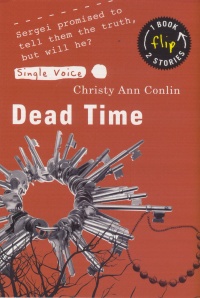| ________________
CM . . .
. Volume XVII Number 36. . . .May 20, 2011 
 |
Dead Time. (Single Voice series).
Christy Ann Conlin.
Toronto, ON: Annick Press, 2011.
184 (87 + 87) pp., pbk. & hc., $9.95 (pbk.), $19.95 (hc.).
ISBN 978-1-55451-286-7 (pbk.), ISBN 978-1-55451-287-4 (hc.).
Grades 9-12 / Ages 14-17.
Review by Joan Marshall.
*** /4
|
| |
|
 |
Includes:
Shelter. (Single Voice series).
Jen Sookfong Lee.
|
| |
|

excerpt:
“But I told you not to see him anymore,” he said, looking at the bruise on my face, putting his head in his hands.
“Yes, I know, Daddy. But I was lonely.” I looked at him and then down again. It was easy to start crying. I used to practice in my bedroom with a stopwatch to see how quickly I could make my eyes fill up with tears. I would think about starving children in Africa, their tiny bodies and bloated stomachs, things like that. I would sit there on my bed, holding my pink princess mirror in one hand and the stopwatch in the other and I would picture poor little children, all alone, children in those refugee camps with no parents, and then the tears would slip over my eyelids and run down my face. Just looking at myself was amazing, how my eyes filled up like fish bowls and the tears slid down in a perfect shape, how sad I looked. It was like watching a star in a movie, this really beautiful girl that no one understands and she’s all alone all the time, her boyfriend’s ex-girlfriend trying to steal him away. (From Dead Time.)
That was the day Sean and I began to talk for real. He sat down and asked me why I volunteer at the shelter, with this open smile on his face as if he didn’t expect anything in particular and just wanted to know what I would say. I told him that I liked the order of the place. Each animal with its own kennel. Feeding schedules posted on the bulletin board. The only time things change are when an animal is adopted or a new one is brought in.
“How about you?” I asked him, suddenly.
“I actually did a business degree, but I’ve always like animals, so when this came up, I went for it. It feels a lot better to help a bunch of cats and dogs than to help a bunch of rich people get richer. And who can resist the puppies?” He grinned and my stomach flipped. (From Shelter.)
In Shelter, Abby’s volunteer work at the local animal shelter is the only bright spot in her life. Her exhausted father works two jobs, her resentful mother defiantly goes clubbing with her younger colleagues, and Abby’s two younger sisters bicker while Abby prepares dinner and gets them all off to school. But then Abby falls in love with the gorgeous Sean, the 23-year-old manager of the animal shelter. Abby longs so desperately for love and support that she strives to be the kind of girl Sean wants – an animal-loving, save the world kind of girl. She’ll do anything to get Sean to love her. But as your grandmother would have said, too bad Sean only wants one thing.
In Dead Time, 15-year-old Isabella is self-centred, narcissist, violent and delusional. She seduces Sergei, an older “bad boy” who’s into drugs but supports his grandmother. Isabella gradually slips into paranoia, suspecting that Sergei’s still involved with a former girlfriend, Lulu. In a climactic forest scene, Lulu is choked and pushed into a pond to die. But who is the murderer? The narrative slips craftily from the real world into Isabella’s disturbed mindset as Isabella tells the story from the detention centre where she is being held. Even Isabella isn’t sure what’s been said aloud. She twists everyone else’s motives and actions to suit her own emotions, raging against her absent mother and her ultra-busy politician father, building a maelstrom of anger and control that swirls around her, propping her up in a giddy swirl of violence. Sergei never knows what hit him. A devoted grandson, he has had trouble connecting with school, but Isabella’s daring, flirtatious behaviour reels him in, and before he knows, it he is under her abusive control, obeying her every command. Isabella’s parents display their own self-centredness: Isabella’s mother abandons her for a beach life with a younger man; her father doesn’t arrange care or companionship for her (much less provide it himself) and is bewildered by her behaviour.
These books are bound together, flipped and back to back, so that one small paperback contains two stories, related by theme. The themes will resonate with the intended reader: seduction for sexual satisfaction versus for love; absent mothers whose disengagement pressures girls to take on an adult role or drives girls into finding love in the wrong arms; the workaholic father. In neither story does technology take a role: no computers, cell phones, texting or twittering. Other than this glaring absence, the stories could take place in the lives of any modern high school student.
The vocabulary is simple, easily read by high school students who are struggling to master reading fluency. The stories are so compelling that students will be quickly drawn in and will be eager to discuss the injustices they find there.
Recommended.
Joan Marshall is a Winnipeg, MB, bookseller.

To comment
on this title or this review, send mail to cm@umanitoba.ca.
Copyright © the Manitoba Library Association. Reproduction for personal
use is permitted only if this copyright notice is maintained. Any
other reproduction is prohibited without permission.
NEXT REVIEW |
TABLE OF CONTENTS FOR THIS ISSUE
- May 20, 2011.
AUTHORS |
TITLES |
MEDIA REVIEWS |
PROFILES |
BACK ISSUES |
SEARCH |
CMARCHIVE |
HOME |

